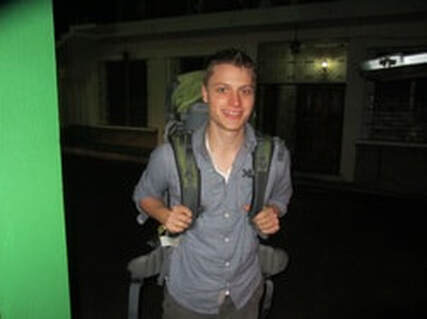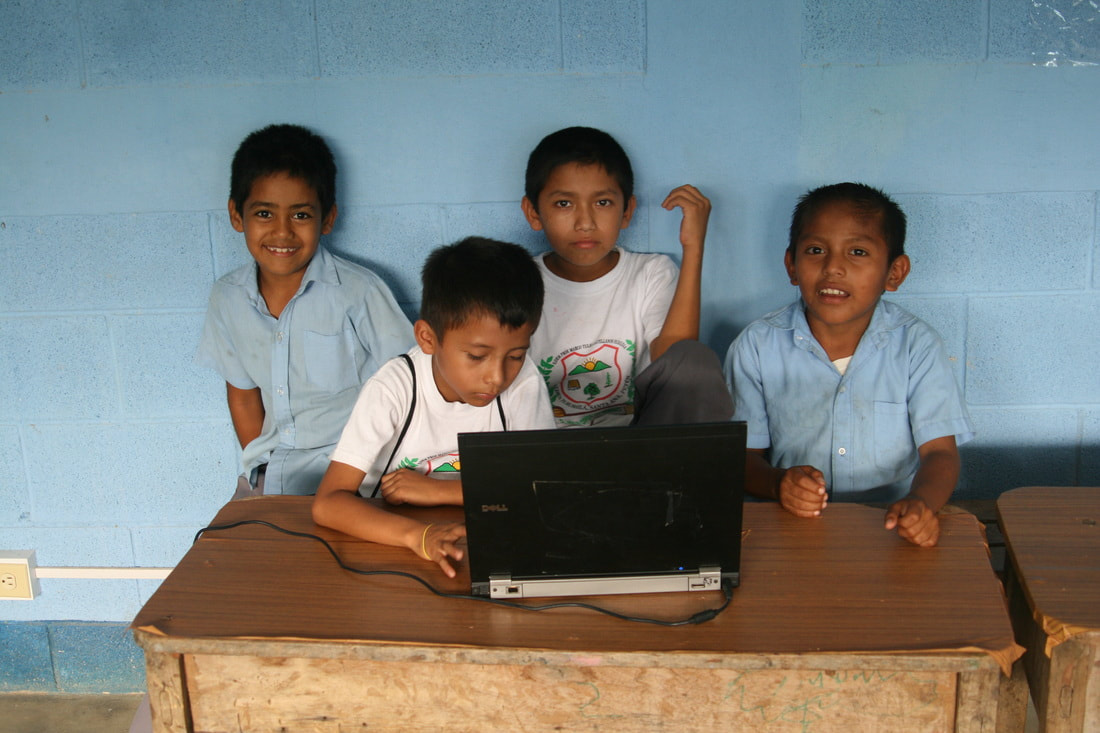|
Last week began a new educational project at the elementary school in Purushila. The program is based off of the SOLE model developed principally by, Sugatra Mitra. The basic premise is that students are presented with exceptionally difficult questions, and through trial and error, collaboration, and a strong support network, they arrive at an answer of their own accord. In this manner the students become their own teachers, and the teacher becomes more of a facilitator, who challenges students and offers encouragement when it is needed. The teacher is not supposed to offer any answers. In fact, in many cases the teacher will not even know the answer. It's perfect for developing nations like Guatemala which aren't exactly know for having an abundance of world-class teachers. It is also quite a bit different from the conventional model which stresses memorization and recitation for tests. The hope is that, by challenging students and offering them all the autonomy they could want, we can make learning fun and engaging again, and certainly much less terrifying.
I'd like to take you through our first day of class. It began with the requisite high-fives, because you just can't pass up an opportunity to lend class that basketball game atmosphere. After that the students took their seats and the following question was raised, “What are the rules of the ancient Chinese game, Mahjongg?” I chose this question because the game could be intuitively searched for on the computer, and once it was discovered, figuring out the rules was only a matter of recognizing a pattern. Needless to say the kids did not exactly fly out of the gate. They all struggled with locating the Mahjongg application on their computers. One group of younger students even struggled with turning their computer on. However, about 30 minutes in, one group finally managed to locate the historic Chinese game. After that it was a matter of seconds before the information had spread throughout the room and everyone was staring at a simulated pyramid of tiles. The game itself consists of removing tiles from the pyramid in matching pairs, however not all the tiles are in play. Tiles can only be used if they are located at the end of a row and are not obstructed by another tile. All other tiles have to be liberated before they can be used to diminish the size of the pyramid. Most of the kids instinctively started clicking on matching tiles however they were confused when some of there efforts were rewarded while others simply yielded no results. They stubbornly kept click matching tiles with limited success until I asked them close their computers and write down everything they knew about the game of Mahjongg. Since I had been watching, I was not surprised when all the groups correctly identified that they game consisted of eliminating tiles by identifying pairs. But there was one group that had slipped my attention, and when it came time for them to present, I was stunned to hear that they had not only identified the method for removing tiles, but had figured out the pattern for determining which tiles were in play and which were not. So there you have it, in an hour and a half the students went from not knowing how to turn a computer on, to both locating and understanding the game Mahjongg. And we've only advanced from there. So far we've observed lunar cycles, explored the worlds longest rivers and glimpsed infinity through the beauty of fractals. It's way to early to call this program a success, but one can only hope that we are instilling in these children the curiosity and creativity to challenge institutions, to crave information and answers from an educational system that's only interested in feeding them complacency. One can only hope we're equipping them with the tools to break free from the cycle of poverty.
0 Comments
Que quiere que haga con la basura? What do you want me to do with the trash? When I heard this question I was confused. The trash being referenced here was a pile of leaves we had just raked up from around the yard. My plan was to use the carbon-rich plant matter to start a compost pile. In my opinion, the pile of leaves was not trash, but an essential ingredient if we were going to make healthy, black soil. While the old adage one man’s trash is another mans treasure certainly applies here, I was more struck by their unfamiliarity with what I considered to be a fundamental principal of farming. You use the waste from last years crop as fertilizer for the next years. In that manner waste becomes food and nothing is lost. But when I asked some locals what they did to amend the soil, nice hard clay, they informed me that normally they sprayed on an artificial fertilizer. While I have no doubt this is effective in the short term, it doesn’t seem practical to forfeit long term soil quality for a practice that is going to require the continual use of costly chemicals. What really bothers me about this is that I’m sure the practice of composting is not new to the Petén, but that through decades of corporate influence, pedaling miracle growth technology, and concentration of land in fewer and fewer hands, the application has been lost. It’s a fundamental case of environmental injustice. The land, having been wrested from the hands of indigenous peoples, has been mistreated and is now being contaminated with artificial fertilizers. The same fertilizers that have been shown to run off of fields during storms and usually wind up polluting water sources. Furthermore, knowledge of how to work the land has been lost. What we’ve started to do at our gardens in Purushila and Santa Ana is break down all of that unused organic waste. It’s not a quick process, nature doesn’t work on the same time scale as us, but hopefully it reintroduces the concept of using waste to grow more food. At the same time we’ve managed to save many leaves from a fiery fate. I spent a Saturday a few weeks ago digging through the dirt looking for worms to help speed up the decomposition process. With the help students, we now have compost piles started in both places and should start turning out high quality soil in another month or so. My hope is that families in the area will pick up the practice of composting so that they can begin their own gardens using the “technology” of their ancestors. Pedro  Dear Friends of SewHope, It is truly with great joy that we welcome Peter Meinecke on our staff in Guatemala. Peter joined our team last week and Randy and I were delighted to be there in Guatemala to welcome him! See the attached pictures - Peter sold his car and all that he brought with him for the year are in his backpack!! Peter graduated from Allegheny College with a major in Environmental Studies and a focus on Community Development. When he graduated, he received a VISTA grant to work here in Toledo developing community gardens at the University Church on Hill Avenue. During his year there, the program "blossomed" and they harvested literally tons of produce which was distributed to the poor. Peter also worked in developing a fish farm on the land - a project which will be a great benefit to our work in Guatemala. We give great thanks to Pastor Julian Davies at the University Church for having the foresight to hire someone like Peter! Peter has a great love of music and plays guitar and piano and best of all, he LOVES soccer - a common denominator that brings rich and poor alike together in Guatemala! Having spent many hours debating politics and social issues with Peter, I can only say that Peter prefers to cut through all the "nonsense" and focus on the real issues - the issues that Jesus gave His life for - restoring the world to what it was intended to be. I cannot tell you how very privileged we feel to have him on board with us. His passion for looking for ways to end injustice, poverty and oppression are the things that our organization stands for. Below are some of the words that Peter wrote when he applied for this position....probably the lowest paid job in America!! "My motive for wanting to join SewHope on a year-long assignment in Guatemala stems largely from my belief that we are all fundamentally called to both identify and right any injustices that occur in our environment. Naturally this can play out in many forms, but the one that speaks to me most right now is the opportunity to dedicate the next year of my life to helping SewHope in your mission to encourage community development in Guatemala, specifically your efforts to raise the quality of living for rural citizens. During my year working at University Church, I was able to work with a number of agricultural systems including hydroponic gardening, vermicomposting, and aquaponics. While I’m certain that some of the skills I picked up while working in the community garden will translate to projects in Guatemala, I am equally excited to learn what different techniques and solutions people such as Ismael, Rudy and Sr. Pam might have. I think it is important not to approach a problem such as this as if you are the rescuer. Instead, I think it is important to recognize inherent differences and benefits of different backgrounds." |
AuthorWrite something about yourself. No need to be fancy, just an overview. Archives
May 2013
Categories |
|
OUR MISSION: SewHope partners with the poor, marginalized, and exploited in Guatemala to help end the injustices of poverty and bring about sustainable communities.
|
© SewHope Inc. All rights reserved.
SewHope is a registered 501(c)(3) nonprofit organization. All donations in the United States are tax-deductible.
EIN: 26-1639100
EIN: 26-1639100



 RSS Feed
RSS Feed